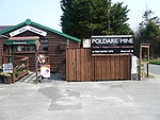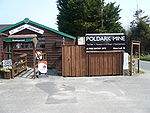
Poldark Mine
Encyclopedia

Tin
Tin is a chemical element with the symbol Sn and atomic number 50. It is a main group metal in group 14 of the periodic table. Tin shows chemical similarity to both neighboring group 14 elements, germanium and lead and has two possible oxidation states, +2 and the slightly more stable +4...
mine
Mining
Mining is the extraction of valuable minerals or other geological materials from the earth, from an ore body, vein or seam. The term also includes the removal of soil. Materials recovered by mining include base metals, precious metals, iron, uranium, coal, diamonds, limestone, oil shale, rock...
in Cornwall
Cornwall
Cornwall is a unitary authority and ceremonial county of England, within the United Kingdom. It is bordered to the north and west by the Celtic Sea, to the south by the English Channel, and to the east by the county of Devon, over the River Tamar. Cornwall has a population of , and covers an area of...
worked sometime between 1720 and 1780. The mine was originally called Wheal Roots and little is known of its early workings. In 1856 it became part of the Wendron Consols Mine and is shown on the surface plan of that mine as 'old men's workings' meaning that it was at that date considered a very old mine. The origins of the mine were researched by the late authority on Cornish mining history, Dr. A. K. Hamilton Jenkin
Kenneth Hamilton Jenkin
Alfred Kenneth Hamilton Jenkin was best known as a historian with a particular interest in Cornish mining, publishing The Cornish Miner, now a classic, in 1927.-Birth and education:...
.
The mine
Because of the unusual way in which Wheal Roots Lode had been worked, there is little doubt that it had been discovered by tin streamers in the bed of the River CoberRiver Cober
The River Cober is a short river in west Cornwall, United Kingdom. It rises near Porkellis Moor in the former Kerrier District and runs to the west of the town of Helston before entering the largest natural lake in Cornwall – Loe Pool. The water is impounded by the natural barrier, Loe Bar, and...
and was from there mined into the hillside. This is exactly the same way that the lodes of the nearby Medlyn Moor, Basset and Grylls and Wendron Consols mines had been discovered and worked. Within the mine, but unfortunately in an area inaccessible to ordinary visitors, area tunnels which were dug without the help of explosives and where the marks of the miner's picks are still clearly visible. This indicates that some of the workings may well have been made before the introduction of explosives in the mines of Cornwall
Cornwall
Cornwall is a unitary authority and ceremonial county of England, within the United Kingdom. It is bordered to the north and west by the Celtic Sea, to the south by the English Channel, and to the east by the county of Devon, over the River Tamar. Cornwall has a population of , and covers an area of...
in 1689.
The mine was worked using horses and water wheels to power all the machinery and to pump water from it. In the Museum there are the remains of an early 'Rag and Chain' pump used before the days of steam to raise water from mines and which was found when the mine was rediscovered in the 1970s. The pump consisted of a series of wooden pipes made from tree trunks and through which a large endless chain was pulled. The chain had rags tied to it at intervals which when pulled up through the pipes lifted the water out of the mine.
The tin ore was pulled out of the mine through shafts using large buckets known as kibbles which were raised up and down by horses driving a large drum around which a rope was attached which went down the shaft to the kibble. The drum was known as a horse whim. When underground at Horse Whim Shaft you can see the granite
Granite
Granite is a common and widely occurring type of intrusive, felsic, igneous rock. Granite usually has a medium- to coarse-grained texture. Occasionally some individual crystals are larger than the groundmass, in which case the texture is known as porphyritic. A granitic rock with a porphyritic...
on the side of the shaft which has been worn smooth by the rubbing of the kibbles against it.
The miners entered the mine through shafts and had to climb down ladders carrying their tools with them. Their only means of light in the pitch black mine was candles made of tallow
Tallow
Tallow is a rendered form of beef or mutton fat, processed from suet. It is solid at room temperature. Unlike suet, tallow can be stored for extended periods without the need for refrigeration to prevent decomposition, provided it is kept in an airtight container to prevent oxidation.In industry,...
. Their tools were a heavy hammer and a bar with a chisel shaped end. Hitting the bar with the hammer and at the same time turning it to prevent it jamming in the rock, the miners would make a hole a little under a meter in depth. Usually they made three such holes at and angle to the face of the rock. The holes would then be filled with gunpowder, a fuse made from a bird's quill filled with fine gunpowder would be put into the hole which would be sealed with clay and then the fuse lit.
Many accidents occurred as a result of the gunpowder
Gunpowder
Gunpowder, also known since in the late 19th century as black powder, was the first chemical explosive and the only one known until the mid 1800s. It is a mixture of sulfur, charcoal, and potassium nitrate - with the sulfur and charcoal acting as fuels, while the saltpeter works as an oxidizer...
exploding before the miners had time to reach a place of safety. Gunpowder produces a lot of smoke and fumes; however, the miners would return to their work as soon as the air had cleared enough to allow their candles to burn. They would remove the rock broken by the explosion and start to drill new holes.
Women and girls were never employed in the mines of Cornwall, in fact it was considered bad luck for a woman to go into a mine. However, they were employed on the surface sorting and treating the ores that had been mined. Boys as young as 10 worked in the mines. While we would consider this child labour today, unlike the coal mines, they usually worked with their father or uncle and were considered to be learning the art of mining.
The Mining Heritage Site 1972
Poldark Heritage site started life in 1972 when Peter Young, a retired Royal Marine, attended an auction in the local hamlet of Trenear with his young daughter Carol. The purpose was to buy a much needed wardrobe. The local forge, Wendron Forge, came up for auction and as the price very slowly rose to £10 Peter thought that the forge was going for a bargain price but was fed up with the slow bidding - to everyone's surprise he bid £100 and became the proud owner of the forge. How he explained the lack of a wardrobe and his new acquisition to his wife we do not know. Next Peter acquired some waste land and with his growing collection of steam engines opened Wendron Forge to the public.With an ever growing collection of steam engines requiring larger and larger compressors to power them there were a growing number of complaints about the noise generated by the compressor. Peter decided to make a cutting in the hillside into which he intended to place the compressor to deaden the noise. Quite by chance in doing so the long forgotten workings of the Wheal Roots tin mine, described in 1856 as 'an ancient tin mine', were broken into and a new project, opening the workings to the public, was commenced.
Wendron Forge first changed its name to Halfpenny Park and later, with the transmission of the BBC Poldark series, to Poldark Mine. A number of scenes were filmed here, including the underground sequences, and a long relationship between the site and Winston Graham
Winston Graham
Winston Mawdsley Graham OBE was an English novelist, best known for the The Poldark Novel series of historical fiction.-Biography:...
, the author of the Poldark
Poldark
Poldark is a BBC television series based on the novels written by Winston Graham which was first transmitted in the UK between 1975 and 1977.-Outline:...
books, developed. This culminated with the launch of the last Poldark book at Poldark Mine in 2002.
In 1999 Poldark was placed in receivership and it appeared that an American buyer might obtain the assets as little local interest was shown in the site. After some protracted negotiations the site and its assets were acquired by the present owners, mining heritage enthusiasts, who formed Transcroft Limited for that purpose.
Poldark is within the Cornish Mining World Heritage Site and is developing itself as the Interpretation Centre for the Wendron Mining District. The site is considered to be a "jewel in the Cornish Mining World Heritage Site crown."

